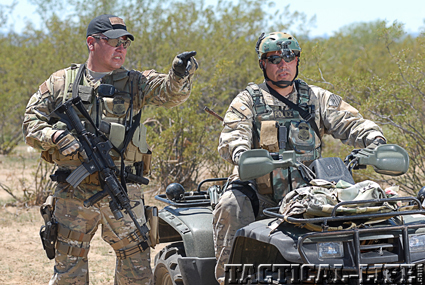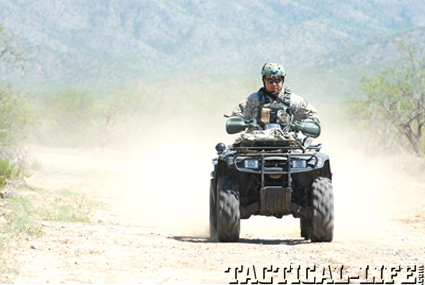In 1972, an act of Congress formally established a special law enforcement unit known as the Shadow Wolves within the U.S. Customs Service. The authorized strength of this unit was set at 25 officers. It was also a requirement that all applicants who wish to serve as members of the Shadow Wolves must be a quarter Native American. Naturally, a Shadow Wolves applicant must also be able to pass a federal background investigation, qualify for secret or top-secret security clearance, complete all required training and serve in a professional fashion with integrity throughout their career.
As a result of the terrorist attacks on 9/11, the legacy U.S. Customs Service and the U.S. Immigration and Naturalization Service were combined to form two federal agencies under the newly instituted Department of Homeland Security. These agencies are U.S. Immigration and Customs Enforcement (ICE) and U.S. Customs and Border Protection (CBP). When this realignment took place, the Shadow Wolves were initially transferred to CBP. In October 2006, the Shadow Wolves were reassigned back to ICE, where they currently serve as a frontline federal law enforcement border interdiction unit that enforces U.S. customs and immigration laws in the western desert near Sells, Arizona.
The name Shadow Wolves was specifically selected because Native Americans respect how the wolf hunts and captures its prey. The 12 current members of the Shadow Wolves unit, who are also known as ICE tactical officers, are responsible for conducting various interdiction and enforcement operations while also gathering intelligence in their area of operation, which comprises 2.8 million acres and includes the Tohono O’odam Native American Nation along the Arizona border with Mexico. A major part of their duties includes tracking smugglers and illegal aliens who enter the U.S. from Mexico.
Wolf Building
According to Rodney Irby, the assistant special agent in charge of the Western Desert ICE Office based in Sells, Arizona, who commands a contingent of ICE special agents as well as 12 tactical officers from the Shadow Wolves unit, “Tracking and cutting sign is a perishable skill. You have to use this knowledge on a regular basis in order to remain proficient.” Two veteran members of the ICE Shadow Wolves unit with whom we spoke noted that it could take as long as two years before a rookie ICE tactical officer becomes a truly proficient member of the Shadow Wolves.
Advertisement — Continue Reading Below
In order to learn their tradecraft, Shadow Wolves must be persistent, determined, patient and committed to honing their tracking skills to perfection. The bottom line is that those who are willing to apply themselves have an excellent chance of learning the skills that are required to serve in a Shadow Wolves unit.
The interesting thing about reading or analyzing sign or being able to interpret tracks—an imprint in the ground, a bent or broken twig, or any disturbance in nature—is that you can actually tell if the track or sign is fresh or old by evaluating several factors. When the imprint is fresh and new, it will have a very clear and distinctive outline and certain level of depth. As wind blows or rain and snow falls, the imprint will begin to lose its clarity and definition. Blowing wind, sand or snow, other human footprints, animal tracks and vehicle tire tracks can also destroy a track or cause an original imprint to be more difficult to read and evaluate.
A good tracker can also tell if a person, a pack animal or a vehicle is carrying a heavy load by the nature of the tracks left behind. Shadow Wolves can often tell whether they are tracking a man, a woman or a child by the distance between footprints on the ground because an adult will have a longer stride than a child. Even something as simple as a disturbance in the shine that some rocks should have on a gravel roadway is enough to indicate to the Shadow Wolves that the subjects of their search have made their way past a particular location.
While tracking someone over rocky terrain, members of the Shadow Wolves unit perform the tedious but important task of inspecting every aspect of this incredibly difficult terrain to see if they can find a small scratch on the side of a boulder, an overturned tiny rock that is definitely not in the proper position, or the lack of desert dust in one area while it is present in another. When they find a second overturned pebble or some other disturbance in nature, they continue tracking until they either run out of signs to follow, they make an arrest or they determine via the circumstances and their knowledge of the terrain that the subject or subjects of their pursuit most likely made their way to freedom and were probably picked up along a long desolate stretch of highway by an accomplice.
Advertisement — Continue Reading Below
On The Prowl
Tracking or cutting sign involves a lot more than tracking clear-cut footprints or other clearly marked indications of travel by smugglers, illegal aliens or a lost child who wandered off but is unable to find their way back. In fact, rarely do the Shadow Wolves find the typical series of clear-cut footprints in the desert that might as well be a sign saying “follow me.” In most instances, members of the Shadow Wolves unit usually have very little to go on and rarely have a well-defined piece of sign to follow. As it was explained to me, Shadow Wolves can take 30 minutes or more just to examine one small area when they begin a tracking operation.
A tremendous amount of patience and attention to detail makes it possible for a member of the ICE Shadow Wolves to find something as simple as thread that was torn from a smuggler’s nylon backpack when he stopped to rest. That small, almost invisible thread may in fact prove to be the one clue that leads another member of the Shadow Wolves to find a partial imprint in the sand, the tiny broken tip of a nearby bush or even evidence that the smugglers have tried to throw off their pursuers by using shrubbery or a collection of branches to “brush out” or cover their tracks when they crossed a dry river bed to change course.
Once the Shadow Wolves begin to track someone, they are relentless. In fact, the Shadow Wolves do some of their best work at night, using inexpensive C- or D-cell flashlights. When canvassing any remote area, members of the ICE Shadow Wolves Unit will examine the terrain like a crime scene technician in an urban area. After years of experience, you get to know how plants grow and how certain bushes and grass react when they are disturbed in any way. The Shadow Wolves have even successfully tracked smugglers who have tied pieces of carpet around their shoes to conceal their footprints in the desert. That’s impressive.
Shadow Wolves will also use ATVs to catch up to a group that they might be hours behind, then they will get out on foot and use their GPS, night-vision goggles and other equipment to help them continue their pursuit. In some instances, when the Shadow Wolves are close to making an apprehension, the smugglers will drop their drug shipment and make a run for it. Those smugglers who fail in their mission because of the tenacity of the Shadow Wolves will either walk back to Mexico or surrender to federal authorities and be voluntarily returned to Mexico.
Advertisement — Continue Reading Below
Shadow Wolves conduct well-planned strategic and tactical operations and do not limit their activities to simply chasing or pursuing smugglers and other subjects. Without giving away any tactics, I can say that when the Shadows Wolves go operational, they evaluate the situation and react accordingly by conducting their operations in conjunction with other teams of tactical officers, ICE special agents and other law enforcement officers from the Tohono O’odham Police Department and the Pinal, Pima and Maricopa County Sheriff’s Departments. In many instances, other law enforcement personnel are used to cordon off escape routes and seal the perimeter while the Shadow Wolves conduct a methodical pursuit in the area. This means that in addition to pursuing subjects from behind, Shadow Wolves will also use other tactics to make an arrest or a seizure. In Old West jargon, this means that when it is necessary the Shadow Wolves will “cut them off at the pass” and use other LE personnel to envelop the subjects of their pursuit or tracking operation.
The Wolf Pack
Members of the elite ICE Shadow Wolves unit are not just a group of highly trained trackers who operate in the Arizona desert. Once they graduate from the Federal Law Enforcement Training Center, Shadow Wolves are sworn in as ICE tactical officers with full arrest and firearms authority.
The Shadow Wolves also represent the U.S. by serving overseas with great distinction as instructors, where they teach allied foreign border guards and border police how to track smugglers and illegal entrants, and conduct tactical interdiction and enforcement operations in their border areas. To date, U.S. ICE Shadow Wolves have served as trainers in various foreign nations, including Kosovo, Estonia, Lithuania, Macedonia, Moldova, Montenegro, Latvia, Kazakhstan, Poland, Slovenia, Oman and Croatia. In addition, Shadow Wolves have also trained the border police in Turkmenistan, Tajikistan and Uzbekistan, which border Afghanistan from the north.
Advertisement — Continue Reading Below
Hunting Success
According to officers interviewed by Tactical Weapons, the Shadow Wolves have an estimated success rate of 75 percent. Clearly, this conservative estimate is an amazing statistic when you consider how hard it is to track people through desert and mountainous terrain that is heavily traveled by smugglers, who are assisted by a complex network of counter-surveillance personnel who operate on the U.S. side of the border to monitor the movements of American law enforcement.
There are only 12 current members of the ICE Shadow Wolves unit in southern Arizona. Current funding is available for additional positions. If you qualify to serve as an ICE tactical officer and you are interested in serving our country in a highly specialized, elite Native American federal law enforcement unit, you may contact the ICE office in Sells, Arizona, for further details about becoming a member of the Shadow Wolves.














































